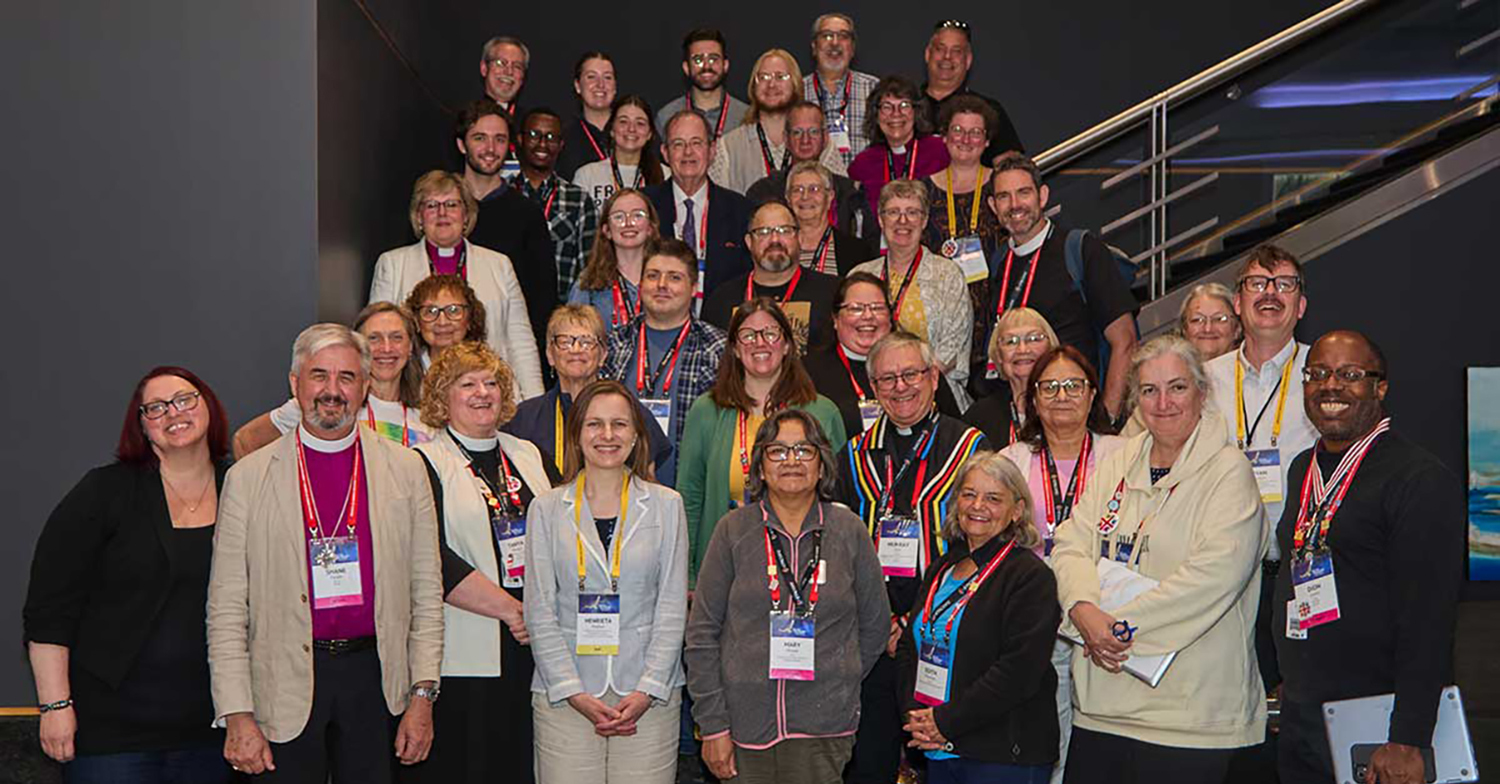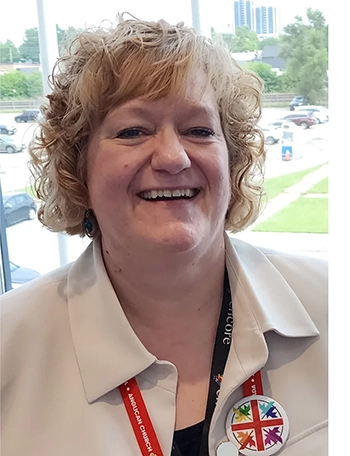
Newly elected members of the Council of the General Synod (CoGS). CoGS carries out strategic planning, coordinates the work of all committees and advises the Primate on matters that concern the welfare of the church.
The CoGS membership includes the Primate, the Prolocutor, the Deputy Prolocutor, the Chancellor, bishops, clergy and lay members of General Synod elected by GS, one youth member of GS from each ecclesiastical province, one member each nominated by the Evangelical Lutheran Church in Canada and the Episcopal Church, and two members nominated by the Anglican Council of Indigenous Peoples. The General Secretary of the General Synod is an ex officio member of CoGS. The Prolocutor is the most senior member of General Synod save for the Primate, responsible for helping in the administration of General Synod meetings and business and chairing meetings in case the Primate is unavailable.
(Photo: Charlotte Poolton/General Synod of Canada)
It is general consensus that by approving PATHWAYS document, General Synod of the Anglican Church of Canada overwhelmingly voted for change. The implementation or the Pathways in now up to the Council of General Synod (CoGS) as its executive body.
Ven. Tanya Phibbs, a long-serving Archdeacon of Huron and, in the last few years, diocesan Secretary-Treasurer, is now CoGS' Prolocutor. In the previous triennium she served as the Deputy Prolocutor. This puts her in a unique position to comment on potential challenges in the implementation of the document. We start our conversation on a personal note.
Congratulations on your election! What does it mean to you personally?
I’m very grateful for the trust that the Synod placed in me by electing me to this role. It’s an opportunity to be involved in the Anglican Church across Canada and to do so at a transformational time in the life of the church – to get to know Anglicans from across the country and to learn from them. It’s exciting and a bit daunting.
Your election to this position comes with the adoption of the Pathways – a document that calls for deep changes in the structure and operations of the Church, if not its entire culture. No pressure there?
There is definitely some pressure on the officers of General Synod to move the work of the Pathways forward. General Synod adopted the Pathways with a vote of over 90%. That is a very clear mandate to get moving, to do something, to move into what Archbishop Anne called ‘a time of holy and sacred risk taking.’ No one wants this to be another report that sits on a shelf and gathers dust. As Sister Elizabeth Anne said, “If you say YES to this [report] and then do nothing, [the church] will die. You must say YES and do the work.” Thankfully there is a great deal of commitment from very gifted people who are willing to step up and say, ‘Yes, we will do this work.’
What do you see as major challenges in the implementation of the Pathways and how to overcome them?
One challenge in many large organizations, and the Church is no exception, is that we spend a lot of time and energy planning, or even planning to plan. So much so that we are tired by the time we get to the actual implementation. Good planning is important but it needs to lead to things being done. Thankfully, the leadership of the Transformation Task Force understands these dynamics and will not get bogged down in the early stages at the cost of moving to implementation.
Changing a beloved institution is always challenging. Discerning what God is calling the Anglican Church of Canada to become over the next years will continue to bring a variety of voices to the table.
 The Primate’s Commission did an outstanding job of consulting with Anglicans across the country. There are clearly areas where there is much common ground and others that may bring more conflict as General Synod begins to make decisions about programs, policies, and people. By the end of this process, our national Church House will probably not look like it does now, the programs of General Synod will probably not look like what they do now, the structures of General Synod will probably not look like what they do now. That can be hard for people. It’s especially true in time where there is change and unease in the rest of society. We look to structures like the Church for stability and resist change within them. Paradoxically, the only way to bring stability to our church in this time will be to transform it.
The Primate’s Commission did an outstanding job of consulting with Anglicans across the country. There are clearly areas where there is much common ground and others that may bring more conflict as General Synod begins to make decisions about programs, policies, and people. By the end of this process, our national Church House will probably not look like it does now, the programs of General Synod will probably not look like what they do now, the structures of General Synod will probably not look like what they do now. That can be hard for people. It’s especially true in time where there is change and unease in the rest of society. We look to structures like the Church for stability and resist change within them. Paradoxically, the only way to bring stability to our church in this time will be to transform it.
The Church throughout Canada is full of passionate, faithful, committed, and gifted people. We are going to need those gifts in order to bring about true and lasting change. The challenge can be that often people don’t think about volunteering at the national level. Often this is because volunteering in their local church and diocese keep them more than busy enough. But we are going to continue to need to discern who we can tap on the shoulder and ask to help lead this change. The strong commitment from General Synod to this work will help in this recruitment. People want to make a difference and will hopefully see being part of this transformation as one way to do that.
The election of the new Primate was quite dramatic and unusual – we have a Primate who was not initially on the ballot! One could wonder if what happened during this process questions “unity in diversity” as the underlying premise for the changes that the Anglican family in Canada wants to implement?
It was unusual and dramatic! But there was also a profound sense throughout the day of this being a communal discernment – of the delegates together seeking God’s choice for our Primate. The election was bathed in prayer and in music– we sang a lot of hymns!
In many ways, we need a Primate for this triennium who is a holy disruptor, who can help the church make changes we need to make. I think it’s interesting that even Archbishop Shane’s election could be seen as a holy disruption – his nomination to the ballot disrupting what might have been originally expected to happen. My sense of Archbishop Shane is that he is committed to diversity in the church as a source of unity and of strength and will work toward that goal.
How do you see the Diocese of Huron and its future in this big picture?
Huron is one of the larger dioceses in Canada. It is sometimes hard to remember this as we watch our numbers declining and parishes closing, but it is true. We have gifted people who can make a difference at all levels of the church, including the national level.
Questions raised by the Pathways may have direct implications for Huron such as the question of communication and the future of the Anglican Journal. If there is no print Anglican Journal, the cost of distributing a print Huron Church News may be prohibitive for the diocese. What other ways can we communicate with Anglicans in Huron? We already have some options – a website and some social media – what else should we be doing?
There may be parts of the administration of General Synod that could be shared with some dioceses – sharing staff members in certain areas for example. Archdeacon Rosalyn Elm is half-time in the Diocese of Huron as the Archdeacon for Reconciliation and Indigenous Ministry and rector of the Parish of Six Nations while also serving half-time as the Director of Indigenous Ministries for our national Church. One of the benefits of this sharing is that it allows each of her roles to inform the other roles, as well as working to prevent the siloing that can happen between the various levels of the church.
Strong dioceses are vital for the future of our national church just as strong parishes are vital for the future of our dioceses. Continuing in our own transformation as we continue Turning to Grace will help Huron to be a strong partner in the transformation of our national church.
